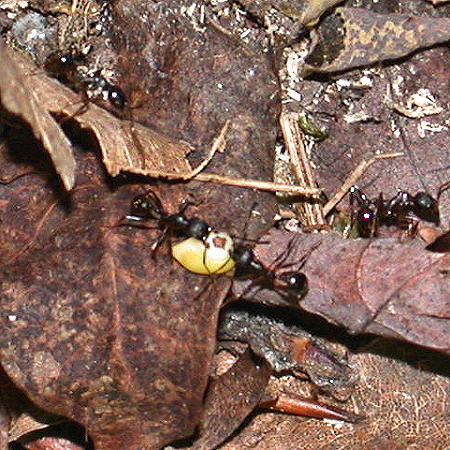I have put together this blog as a supplement to my main website, www.thismia.com, which is devoted to native plants of the Northeastern United States. This first entry is about my observations of ants dispersing seeds in a deciduous forests of the northeastern U.S. This was part of a pilot study that was eventually designed to measure the frequency of ant dispersal of Trillium seeds in post-agricultural forests.
There is a large, lipid-rich structure called an elaiosome attached to the seeds of Trillium spp. which serves to attract ants (when ants disperse plant seeds this is known as myrmecochory). This structure also attracts ground beetles, slugs, and sometimes yellow jackets. In the case of beetles and slugs, the elaiosome tends to be consumed in place and the seeds do not get dispersed. Also, after the elaiosome is consumed ants will no longer gather the seeds. It is likely that seeds which have the elaiosome removed will germinate close to the parent plant, and this has been confirmed by seed exclosure experiments using seed of Erythronium americanum (Wein and Pickett 1989). Ants disperse nearly one-third of herbaceous woodland angiosperm seeds (Beattie and Culver 1981), and therefore short-distance dispersal that could expand local plant populations may be limited by ant activity. Ants have been shown to disperse the seeds of myrmecochorous species (e.g., Trillium grandiflorum (Michx.) Salisb.) only < 2.4 m away from parent plants in a single year. Occasional long-distence dispersal by yellow jackets may be important for the eventual recolonization of Trillium and other ant-dispersed plant species in secondary forests. Most of the time yellow jackets do not disperse Trillium seed much further than ants do, but can occasionally disperse seeds more than 20 meters from the parent plant (Zettler and Spira 2001).
The image is of ants dispersing Trillium erectum seeds that were placed on a rock in a forest in central NY. A previous seed sowing experiment conducted in Denmark had reported an absence of ants within secondary forests (Petersen and Philipp 2001). I was ultimately urged to remove this study from my thesis but I was able to demonstrate that ant activity was quite high in secondary forests in central NY, and possibly higher than ant activity in primary forests in the region.
Works Cited
Petersen, P.M. and M. Philipp. 2001. Implantation of forest plants in a wood on former arable land: a ten year experiment. Flora 196:286-91.
Wein, G.R. and S.T.A. Pickett. 1989. Dispersal, establishment, and survivorship of a cohort of Erythronium americanum. Bulletin of the Torrey Botanical Club 116:240-246.
Zettler, J.A. and T.P. Spira. 2001. Yellow jackets (Vespula spp.) disperse Trillium (spp.) seeds in eastern North America. American Midland Naturalist 146:444-446.

Since seed dispersal by ant is a slow process, how can the gaps in distribution be accounted for: Eastern Asia, Western U.S., and Eastern U.S.?
Comment by Phil — May 10, 2011 @ 15:52
I meant North America, not U.S.
Comment by Phil — May 10, 2011 @ 15:58
I am probably not the best person to ask but you do raise an interesting question. Past glaciations have no doubt influenced the current distribution of most northern species. While ants are the primary means by which the seeds are dispersed, deer are known to occasionally eat the fruits and distribute them over rather long distances. And although wasps and deer have been identified as alternate dispersal vectors there may be other organisms, like birds, that could occasionally disperse the seeds as well.
Comment by admin — May 10, 2011 @ 18:32